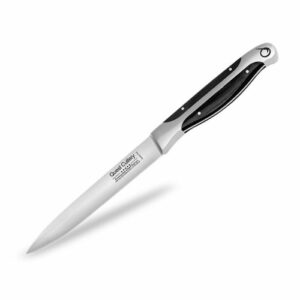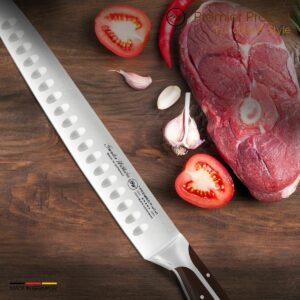The Essential Guide to Utility Knives
The Essential Guide to Utility Knives: Versatile Tools for Every Kitchen

One of the epiphanies that illuminate you along the way is the simple realization that you need a workhorse. Yes, it’s good to have a bunch of highly specialized knives — carving knives, slicers, boning knives, even charcuterie knives — that’s all well and good. But you also need a jack-of-all-trades blade that you can apply to any number of situations. Enter the standard utility knife.
A versatile blade that will aid you in a wide variety of culinary challenges: slicing, trimming, sectioning, coring, peeling, and what have you. Think of it as the midway point between a chef knife and a paring knife. In the kitchen, the utility knife is the in-between point that will make your cooking experience that much easier and more convenient.
A well-equipped kitchen is incomplete without a reliable utility knife. These versatile tools have earned their place as culinary essentials, seamlessly tackling a wide range of tasks, from slicing bread and cheese to chopping vegetables and meat. Their compact size and maneuverability make them ideal for precise cutting, complementing the larger chef’s knife.
If you’re going to get a utility knife — and you should! — make it a good one. Let’s talk about what makes a good utility knife.
Why You Need a Good Utility Knife?
Since the utility knife is your jack of all trades in the kitchen, there are a number of important factors to consider. These factors will vary significantly depending on the level of use you’ll be giving it. Are you a chef in a commercial kitchen? Or are you just a home cook with a zeal for kitchenware?
Whatever the case, you’re going to be using your utility knife a lot, so comfort is an extremely important factor. Look for handles that are ergonomically designed to be used for a long time, and sometimes for tough jobs. It’s not just a matter of feeling nice — if you have a knife with an uncomfortable handle, it might result in fatigue or even an accident. Comfort is a fundamental part of safety.
A good utility knife is a true kitchen workhorse, offering a multitude of benefits, including:
- Versatility: Utility knives can handle a variety of tasks, making them indispensable for everyday cooking.
- Precision: Their smaller size and maneuverability allow for intricate cutting and detailed food preparation.
- Ease of Use: Utility knives are comfortable to hold and provide excellent control, simplifying even the most delicate tasks.
- Durability: High-quality utility knives are crafted from durable materials, ensuring long-lasting performance.
What to Look for in the Best Utility Knife?
The standard utility blade is extremely important, and we’re not talking about a replaceable blade. A workhorse like the utility blade is going to be doing a lot. A dull blade is no good. You’ll be making all manner of cuts with this tool, so you need a cutter. Pay special attention to the level of sharpness of the utility knife blades when you’re looking through the utility knife’s specs prior to buying. Whether it’s a stainless steel blade or a ceramic blade makes a difference.
There’s also the question of how much you want to spend. You’ll find that most high-quality utility knives won’t exactly break the bank, but the difference between an inexpensive utility knife that will quickly go dull and not sharpen as well after a few months of use (you’ll need to have a spare sharp blade hanging around!) vs. a slightly more expensive utility knife made out of high-quality materials is worth it.
When selecting a utility knife, consider these key factors:
- Blade Length: Utility knives typically have blades between 5 and 7 inches, a versatile size for most kitchen tasks.
- Blade Material: High-quality stainless steel blades offer superior sharpness, durability, and resistance to corrosion.
- Handle: Choose a handle that is comfortable to grip, made from durable material, and provides a non-slip surface.
The Best Utility Knives
Gunter Wilhelm offers an impressive selection of utility knives, each designed to meet specific needs and preferences:
- Utility Knife, 5 Inch | Black ABS Handle

This versatile knife features a sharp, high-quality stainless steel blade and an ergonomic handle for comfortable use. - Serrated Utility/Steak Knife, 5 Inch | Brown & Grey ABS Handle

This serrated knife excels at cutting through tough foods like tomatoes, bread, and meat, thanks to its durable blade and comfortable handle. - Serrated Utility/Steak Knife, 5 Inch | Dark brown ABS Handle

Another excellent option for cutting tough foods, this serrated knife boasts a sharp, durable blade and a comfortable grip. - Serrated Utility/Steak Knife, 5 Inch | Brownish ABS Handle

This serrated knife offers a similar performance to the previous models, with a slightly different handle design. - Serrated Utility/Steak Knife, 5 Inch | Reddish ABS Handle

For those seeking a vibrant addition to their kitchen, this serrated knife features a sharp, durable blade and a striking red handle. - Utility Knife Quest, 5 Inch | Dark Pakkawood Handle

This stylish knife combines a sharp, high-quality stainless steel blade with a beautiful pakkawood handle, adding elegance to any kitchen.
Frequently Asked Questions About Utility Knives
Q: What is the difference between a serrated knife and a straight-edge knife?
A: The main difference between a serrated knife and a straight-edge knife is the blade. A serrated knife has a saw-like blade, while a straight-edge knife has a smooth blade. Serrated knives are better at cutting through tough foods like bread, tomatoes, and meat, while straight-edge knives are better at slicing and chopping.
Q: What is the difference between a utility knife and a chef’s knife?
A: Utility knives are smaller and more maneuverable than chef’s knives, with shorter blades. They excel at precise tasks like slicing bread and cheese, while chef’s knives are better suited for larger tasks like chopping vegetables and meat.
Q: How should I care for my utility knife?
A: Hand-wash your utility knife with mild soap and water, drying it immediately after washing. Regular sharpening is essential to maintain optimal performance.
Q: How often should I sharpen my utility knife?
A: How often you need to sharpen your utility knife will depend on how often you use it and how hard the foods you cut are. A good rule of thumb is to sharpen your knife every few months, or more often if you use it frequently.
Conclusion
A good utility knife is an essential tool for any kitchen. It’s versatile and can be used for a variety of tasks. If you’re looking for a high-quality utility knife, then look no further than Gunter Wilhelm. We offer a variety of utility knives to choose from, so you can find the perfect one for your needs.





















